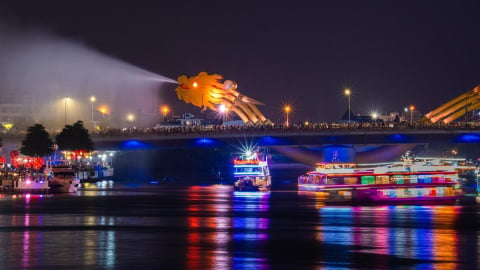Article and photos: Tran Viet Anh
Jeepneys are the most popular means of transportation in the cities of the Philippines. It is said that when you come to the Pearl of the Orient, you must experience a ride on one. If you travel by taxi or spend all day on the speeding subway (at least in Manila), the enjoyment will be far from reaching its peak.
.jpg_0.jpg)
Jeepneys are shaped like jeeps, but have a roof so that passengers do not have to endure the scorching heat of this tropical land. The ceiling is very low, so people can only bend down to get to their seats, and standing is "helpless". Unlike regular jeeps, the rear of the vehicle is extended to be able to carry more people, sitting on two rows of wooden seats arranged along the side of the vehicle. With that many seats, about 16 people can sit in the passenger compartment, and the driver's compartment can also hold up to 3 more people. Of course, with two rows of people crammed into such a narrow space, it is difficult for people not to sweat on hot summer days. Luckily, the windows on the vehicle are not fitted with glass, allowing cool breezes to blow through, making everyone feel comfortable as the vehicle rolls.
.jpg_1.jpg)
The most special thing about jeepneys in the Philippines is that no two jeepneys are the same color. They are operated by transport companies, large or small, so people are free to paint and decorate them as they like. There are countless flashy vehicles that make tourists feel like they are in a South American carnival world. On the outside of the vehicle, the owners often write the names of the stops, but in fact, customers can request to stop anywhere they want. This is truly a fun playground for artists to let their colorful imaginations fly high.
.jpg_3.jpg)
The experience of being a new passenger is interesting. You will have to be ready to bend down to get on the jeepney from the back to get to the seat closest to the driver, as the passengers who boarded earlier will not give you a seat at the back. Alternatively, you can also use your hand to knock hard on the side of the vehicle to ask for a seat, or say “sebum”, but don’t bet on that! Sometimes the car is so cramped that some people have to stand outside the vehicle, or sit on the roof, reminiscent of the market buses in Vietnam. If the jeepney you are on has a conductor, he will be an interesting companion while you hang on outside. In many places, the roof is where goods, baskets, trays or whatever belongings of the working people are piled.
.jpg_2.jpg)
Most jeepneys have no conductors, just a driver. So how much do you pay? It all depends on your honesty. The person sitting far away asks the person sitting near to pass the money to the driver, 8 pesos (about 4,000 VND) at a time. If there is change, the driver asks the person sitting near to pass it to the person sitting far away. This tradition has helped build the honesty and truthfulness of the Filipino people. To get off? Say “para” (if you are in Manila), or simply knock on the ceiling to signal the driver. If you are on the sidewalk and want to get on, just wave your hand and the jeepney will stop at your place like a taxi.
These cheerful vehicles are not without their fair share of troubles. Road users will surely frown at the black smoke coming from many decades-old jeepneys. Besides, the “innocent” stops to drop off passengers make the traffic jam nightmare in Philippine cities even more painful. The roads are crowded, the time is running out, and some drivers even cut a few stops to get to their destination faster!
In Thailand there is tuk tuk, and in the Philippines there is jeepney. The traditional small passenger vans have left an indelible mark on the minds of the people of this beautiful island nation. If you are afraid to walk, there is the jeepney. If you have little money, there is still the jeepney. Blending in with the Filipino people means that tourists have to sit quietly on the narrow benches of the jeepney.
| 'Jeepney' is a combination of 'jeep' and 'jitney' (a small public transport vehicle) in English. Originally, these vehicles were American military vehicles left behind after World War II. Local entrepreneurs took advantage of hundreds of them and converted them into jeepneys. At that time, this was the best way to get around because the public transport in the Philippines had been completely destroyed by bombs. Today, they are mass-produced by local manufacturers, and jeepney drivers must have a specialized driver's license. |





.jpg.jpg)




























